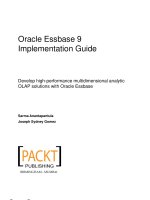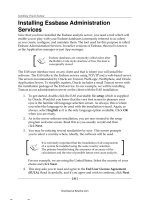Oracle Essbase 9 Implementation Guide- P13 pot
Bạn đang xem bản rút gọn của tài liệu. Xem và tải ngay bản đầy đủ của tài liệu tại đây (705.39 KB, 5 trang )
Chapter 2
[ 45 ]
Click OK. Hurray! you have now created your rst Essbase application. Now that
you have created your Essbase application, let us take a quick look into the Essbase
application properties.
Essbase Application Properties
As the name suggests, Application Properties will allow you to set the properties for
an application. You can update the name of your application, set the start up options,
and also set the initial security levels. These properties can only be changed using
the EAS by any user who at least has an access level of Application Designer to the
application being updated and by automated scripts like Essbase command scripts
or Essbase MaxL scripts. These scripts are explained completely later in this book.
There are two ways to get to the Application Properties:
1. Click on the name of the application to select it, then click on the Action
menu on the EAS menu bar. Now, click on the Edit Properties for "Esscar".
2. Click on the name of the application to select it and right-click over the
application name. Here, you will also see Edit Properties for "Esscar" as
one of your choices.
This material is copyright and is licensed for the sole use by Paul Corcorran on 5th July 2009
8601 ave. p #1, , lubbock, , 79423
Download at Boykma.Com
Essbase Data and Design Considerations
[ 46 ]
Startup section
This property is used to tell Essbase how to automatically start the application.
There are two ways you can start an Essbase application:
• Allow users to start application
• Start application when Essbase Server starts
By default, Allow users to start application is selected and we advise you to leave
it as it is. Only select the second option when it is absolutely necessary for the
Essbase server to start your application. As you have previously learned, if an
inactive application is started it will unnecessarily consume system memory.
One of the only times it may be necessary to have an application start (when the
Essbase server is started) is if you have an automated batch process which starts
immediately following a server restart. This might be performed during routine
server maintenance or housekeeping.
Security
There are several different types of security commands. They are listed as follows:
• Allow commands: If checked, this allows users to run commands on the
database in the application. This option is selected by default.
• Allow connects: If checked, this allows all users with proper access to connect
to the application. When unchecked, only the Application Designer, or higher
users, are allowed to connect to the database. This option is selected by default.
• Allow updates: If checked, this allows the users with appropriate access
to update the data in the databases. This option is selected by default.
• Enable security: If this option is unchecked, then Essbase ignores all of the
security settings and gives Application Designer access to all of the users.
This option is selected by default and we recommend you keep it that way.
Minimum access level
This setting sets the minimum access level for all databases within an application,
and grants this access level to all valid IDs created on the server. The setting can
be overridden at the database level, but it's really a good idea to leave it set to none
at the application level. This property will be discussed further, in detail, in the
database properties section of this chapter.
This material is copyright and is licensed for the sole use by Paul Corcorran on 5th July 2009
8601 ave. p #1, , lubbock, , 79423
Download at Boykma.Com
Chapter 2
[ 47 ]
Types of Essbase databases
Essbase offers two types of databases that can be created. The rst and most
important choice is the normal or standard database. This database will be used
in 100 percent of the applications you build in Essbase.
The normal (non-currency) database
The normal non-currency database is the cube you have heard so much about. All
data dimensions and members are dened in the outline of this cube. The normal
Essbase database is widely used for most data analysis where conversion of currency
values is not required. In our Esscar Motor Company example, we could track and
forecast vehicle production, sales volumes, trends, stocks, and all quite nicely with
a simple to use non-currency database.
Essbase currency database
The currency conversion database is a great tool for analyzing data across
international markets, which employ differing currencies. The currency conversion
database stores the currency conversion values for each individual country. When
currency data is requested by the user in his local currency, the normal cube will
dynamically access the currency cube and convert the data on the y.
The symbiotic currency cube can be conceptually
thought of as the currency dimension of the primary
normal
cube.
Database components
Let's now go through some of the most important components in every database.
• The database outline
• Linked Reporting Objects
• Partitions
• Calculation scripts
• Report scripts
• Rules les
This material is copyright and is licensed for the sole use by Paul Corcorran on 5th July 2009
8601 ave. p #1, , lubbock, , 79423
Download at Boykma.Com
Essbase Data and Design Considerations
[ 48 ]
The database outline
The database outline denes the structure of the multi-dimensional database,
including its hierarchies, member formulas, and child to parent consolidations
(data rollups).
Once a database is created, an Essbase outline is also created with the same name.
This le is saved on the Essbase server with the
.otl extension. In the next chapter,
we talk in-depth about the Essbase outline.
Linked Reporting Objects
Using the Linked Reporting Objects (LRO), you can attach an object to a cell.
For instance, you could have a owchart attached to a specic value in a cell
alerting the user when the value was requested.
This object can be any of the following items:
• Cell note
• An externally created le like Microsoft Word, an image, or another
Microsoft Excel le
• URL
• Another Essbase database
Partitions
Simply put, a partition is a slice of information from one database that is shared
with another database. There are three options for partitioning data in Essbase.
• Transparent partition: Allows the users to access data from the source
database as though it were stored in the target database. The source can be
another database in another application or even on another Essbase server.
• Replicated partition: Is a copy of a slice of data from the source database
that is stored in the target database.
• Linked partition: A linked partition points users from a cell in one database
to a cell in another database. A linked partition can give users a different
perspective of the data.
We will talk more about Essbase partitions in Chapter 8.
This material is copyright and is licensed for the sole use by Paul Corcorran on 5th July 2009
8601 ave. p #1, , lubbock, , 79423
Download at Boykma.Com
Chapter 2
[ 49 ]
Unless otherwise specied by you, the user, all Essbase le objects,
including calculation scripts, report scripts, data load rules les, database
index and page les, and database control les are stored on the Essbase
analytic server using the server's own operating system's resident le
system and are located in the default %Arborpath%/App/Database path.
When you install Oracle Essbase on your server and your client, the installation also
creates new environment variables on your machines. The ARBORPATH environment
variable is basically the path name all the way down to the Essbase folder itself. In the
following screenshot, you can clearly see how the Essbase folder structure is laid out:
Calculation scripts
Essbase calculation scripts (Essbase le objects with the .csc extension) contain
specic calculation instructions, written by you, that Essbase will use to perform
specic calculations on the data. Essbase calculation scripts are actually ordinary
ASCII text les which can be edited in a simple text editor, like Notepad, or which
can be edited using the calculation script editor in the EAS. Essbase database
calculation scripts are discussed in full detail in Chapter 4.
This material is copyright and is licensed for the sole use by Paul Corcorran on 5th July 2009
8601 ave. p #1, , lubbock, , 79423
Download at Boykma.Com









